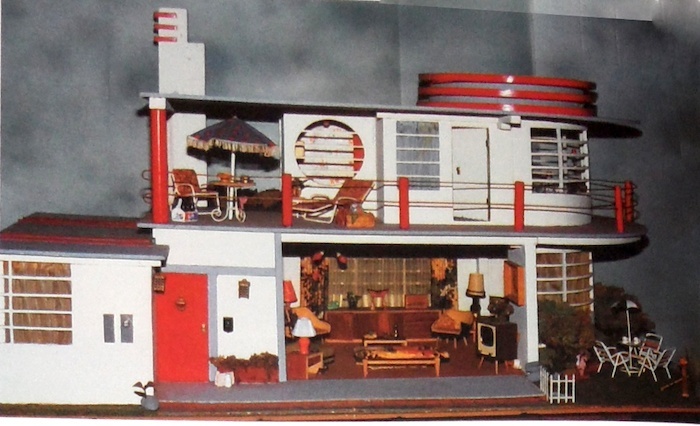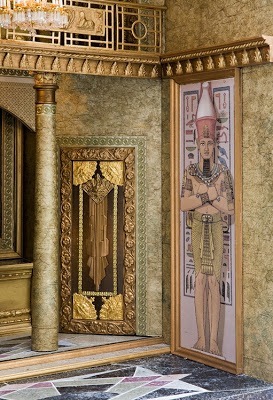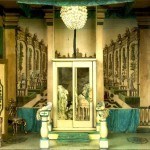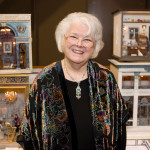Art Deco Needs More Love
I am not sure why we don’t see more art deco miniatures. It’s a wonderful era for dollhouse enthusiasts. You can have all the shiny, colorful objects you want. Flamboyant murals or stylized images from nature. Almost anything goes, as long as it’s declarative and streamlined.
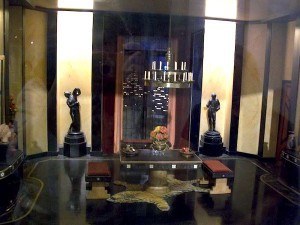
Thorne Art Deco Penthouse Dining Room found at the Phoenix Art Museum
It is not that art deco is completely ignored. One of the Thorne Room miniatures is the Art Deco Penthouse Dining Room. And Marc Mead did a wonderful electrified art deco media room. Bluette Meloney and her students have created some marvelous pieces, with decorations galore
Perhaps the decorative aspect is why art deco had such brief popularity. The fine art and design community never took it seriously, considering it ornamental, not serious works of art.
But if you are looking for a colorful, flamboyant project, with lots of bling possibility, art deco might be just the ticket.
Historical Context
Europe was ready for a bust-out. After the horrors of trench warfare and the deprivations that followed, Europe and the US. were ready for a good time. The Roaring Twenties and the Jazz Age gave them the excuse. Traditions in art, design and morals gave way to opulence and extravagance. The Swiss architect Le Corbusier gave the art deco movement its name after Paris Exposition Internationale des Arts Decoratifs et Industriels Modernes in 1925. Its theme was characterized by vibrant colors and streamlined shapes.
Not everyone approved, especially Le Corbusier. He deplored the useless ornamentation but used the streamlining and central circular form in many buildings. The Villa Savoye has a circular ground floor garage. The dimensions were determined by the turning radius of a 1927 Citroen.
Hey, art students! How’s that for function before form!
Art deco utilized modern materials like chrome, stainless steel, and inlaid wood. If a designer dabbled with natural materials, they tended to be graphic or textural, like zebra skin or jagged fern leaves. As a result, art deco featured bold shapes – sunbursts, zigzags, broad curves.
Interiors have the most uses of art deco. There are some amazing exteriors, however. Check out the spire of the Chrysler Building in New York, or the hotels on Miami’s South Beach.
Let’s Pretend
Let’s Pretend was a half-hour Saturday morning radio show for kids – many, many years ago. Actors guided us through all sorts of make-believe situations. I use the same fantasy technique to create the 1:12 scale inhabitants of my miniatures today.
So, who do I want to live in my art deco room box? How about a flapper, a slightly naughty young lady who regales her staid relatives at family gatherings with lurid tales of her wickedness after she has taken on a snout-full of absinthe. These show-and-tells take place after the adults THINK the children have gone to bed. What would my flapper have in her apartment? Let’s have her indulge in outrages flights of fancy, with every item modern and shiny, streamlined, with rounded edges. And color, lots of color! Keep the following points in mind as we decorate her room.
Art Deco Design Principles
geometric and angular shapes
chrome, glass, shiny fabrics, mirrors and mirror tiles
stylized images of airplanes, cars, cruise liners, skyscrapers
glass – glass bricks on exterior and interior walls, etched or sandblasted panels
nature motifs – shells, sunrises, flowers
theatrical contrasts – highly polished wood and glossy black lacquer mixed with satin and furs
furniture – choose strong, streamlined shapes for furniture and in single pieces rather than suites.
fabrics – stick to plain or geometric fabrics and add highlights with cushions also in one solid block of color.
floors – plain polished parquet is perfect for floors. Linoleum in abstract designs or black and white chequerboard vinyl tiles are also typical.
rugs – floors would have been overlaid with a large rug in geometric patterns. These were often handmade by artists such as Duncan Grant (of Bloomsbury Group fame).
fireplaces – fireplaces should be rectangular and bold. Surrounds were often tiled in pink, green or beige. They were made of concrete and not many survive today.
color – halls suit bold color schemes such as silver, black, chrome, yellow and red. Creams, greens, and beige, or oyster and eau-de-nil suit living rooms and bedrooms.
cupboards – cabinets, wardrobes, etc should be in pale veneered wood and simple shapes in keeping with the light, airy feel.
design – the stepped profile is the epitome of the art deco shape, found everywhere from up-lighters to picture surrounds. Also look for zigzags, chevrons and lightning bolts.
lighting – lights featuring female figures holding the ball of the lamp are typical and good reproductions abound. Also look for chrome, a brand new material at the time, and glass. Glass would have been etched, sandblasted or enameled rather than colored.
Those Were The Days, My Friend
Art deco began its decline at the beginning of World War II. Daily news about atrocities and death in the 1940s made frivolous ornamentation seem inappropriate. The shock of the atom bomb sobered us all.
But that’s history; we’re talking about dollhouse miniatures, here. If you are not sure what your next project should be, give art deco some thought. Even the planning stage can be exciting.
Susan Downing, with Patrick Owens


